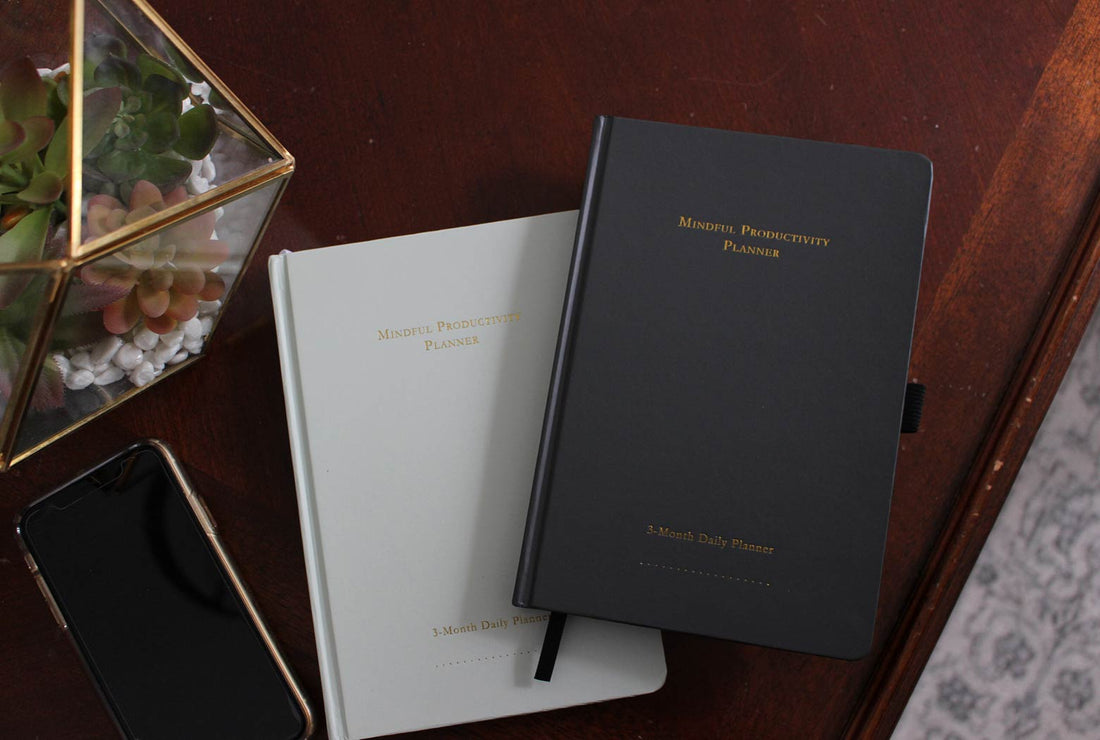
Being diagnosed with ADHD at 31 was such a relief! There was a medical reason why “easy” things always seemed so hard for me. ADHD is a neurodevelopmental disorder, which means that our brains develop differently. According to Dr. Russell Barkley’s book, Taking Charge or Adult ADHD, 4-5% of adults have ADHD. That’s 1 in every 20 people!
ADHD is an impairment in what are called executive functioning skills such as: organizing, planning, prioritizing, initiating, sustained attention, verbal working memory, visual working memory, time-management, and emotional regulation (the pause between feeling an emotion and acting on an emotion). In order to manage ADHD, it’s so important to have as many supports and strategies as possible.
One of my many strategies was using a productivity planner. Sadly, the planner I used for years was discontinued, and many tears were spilled while looking for a comparable replacement. I took a chance and reached out to Leslie at Do Good Paper Co. to ask if she would consider making a custom undated productivity planner. Coincidentally, she was already thinking about making an undated productivity planner and said she would welcome my input.
The Mindful Productivity Planner is full of features that support ADHDers and neurotypical people alike:
- Undated, so you can start it at any time;
- Month-at-a-glance, and week-at a glance pages to help you keep the big picture in mind;
- Meal planning, water tracking, and exercise and mindfulness recording because you need to be well to be productive;
- Blank pages for brainstorming!
- AND, it’s PRETTY!
There are many things I love about this planner but let me highlight some features that are particularly helpful to ADHDers.
Goal-Setting Pages (at the beginning of each month):
How to use it: The areas to record personal, work/school, and other goals will help you constrain and reduce overwhelm. Where do you want to direct your energy throughout the coming month? Write what you want to produce by the end of the month (A completed chapter of your book, three new sales accounts, a completed methods section of your thesis, a calmer state of mind etc.). Write down a concrete action plan that will help you get there and include a reward for yourself to keep you motivated, because working on our goals isn’t always the most fun.
Why it helps: This section supports visual working memory, prioritising, planning, and sustained attention. When you don’t take the time to visualize your goals and priorities, you forge ahead without a plan. Then you find yourself bouncing from task to task because EVERYTHING seems important. Having written goals help keep your eyes on the prize.
Pomodoro Technique (on the daily planning pages)
How to use it: On the daily planning pages, you will find little circles split in halves beside each of the items in the To-Do list. This is the Pomodoro Technique and I owe this technique a lot. It involves working on a single task for 25 minutes at a time. Set a timer for 25 minutes (try not to use your phone if possible), put away any distractions (like your phone), and work for 25 uninterrupted minutes. When the timer goes off, fill in one of the circle halves, then set another timer for 5 minutes and take a short break. Then come back and set the time for another 25 minutes. Once you have done four 25-minute intervals in a row, take a 30-minute break.
Why it helps: This technique helps with sustained attention, time-management, and prevents procrastination. Reminding myself that I can handle 25 minutes of a task makes me more willing to start. If you don’t know how long a task will take you to complete, decide on how many 25-minute blocks you are willing to work on it for. You’ll probably be surprised by how much you can get done in 25 minutes.

Weekly and Monthly Check-in (at the end of every week and month)
How to use it: These pages will help you pause and reflect on your progress. In the weekly review, go through each goal and evaluate how well you stuck to your action plan, identify distractions or habits that got in your way and develop solutions to use in the upcoming week. In the monthly review, decide if your goal was achieved or not. Review what did or didn’t work and decide on next steps or goals. Also enjoy that reward if you achieved your goal!
Why it helps: These sections help with working memory, sustained attention, and self-evaluation. As all-or-nothing thinkers, ADHDers have difficulty noticing progress. These evaluation pages will help highlight your progress and encourage problem-solving. Use them as tools to help you grow.
Tips for Starting
Learning to use a planner takes time and practice, especially for ADHDers, so please don’t be discouraged if it’s not as easy as you hoped. Use the undated aspect of the planner to your advantage. If your use of the planner was totally spotty one week, just erase the week and pick up where you left off. No guilt. No need to beat yourself up.
The tools in the Mindful Productivity Planner are helpful for everyone. I hope you impress yourself with what you get done.
To learn more ADHD management tools, come join me for mindful breath and movement at my online yoga studio, ADHD yoga. I would love to practice with you. If you want to learn more about life with ADHD, follow me on Instagram
-- Written by Taucha Post
---------------------------------------------
Taucha is a certified yoga teacher and registered speech therapist. She was diagnosed with ADHD at 31 and has spent a lot of time figuring out what that means to her. She is the founder of ADHD yoga, an online yoga studio that empowers fellow ADHDers and encourages them to connect with themselves and each other through mindfulness, movement, and breath. She believes that good ADHD treatment involves a combination of strategies, medications/supplements, tools, community, and professionals (if accessible); however, the most important piece of all is self-acceptance. You can practice live with Taucha or access her recorded yoga class library at adhdyoga.ca.

